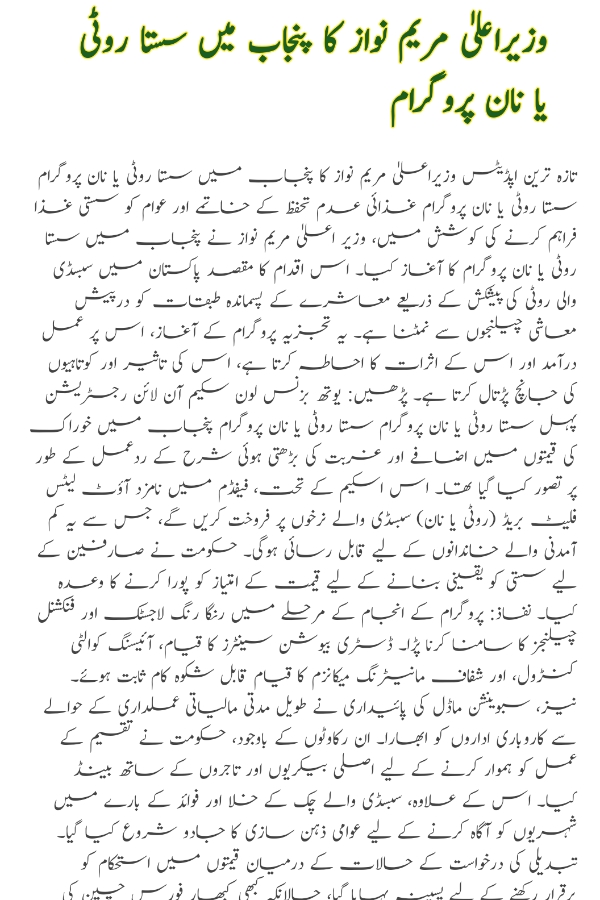Sasta Roti or Naan Program
In an endeavor to alleviate food insecurity and provide affordable sustenance to the masses, Chief Minister Maryam Nawaz launched the Sasta Roti or Naan Program in Punjab. This initiative aimed to address the economic challenges faced by the underprivileged sections of society by offering subsidized bread, a staple food in Pakistan. This analysis delves into the inception, execution, and repercussions of the program, scrutinizing its effectiveness and shortcomings. Read: Youth Business Loans Scheme Online Registration
Initiative Sasta Roti or Naan Program
The Sasta Roti or Naan Program was conceptualized as a response to raising food prices and burgeoning poverty rates in Punjab. Under this scheme, designated outlets across the fiefdom would sell flatbread( roti or naan) at subsidized rates, making it accessible to low- income families. The government pledged to cover price discrimination to insure affordability for consumers.

Implementation:
The perpetration phase of the program encountered colorful logistical and functional challenges. Setting up distribution centers, icing quality control, and establishing transparent monitoring mechanisms proved to be redoubtable tasks. Also, the sustainability of the subvention model raised enterprises regarding long- term fiscal viability. Despite these hurdles, the government banded with original bakeries and merchandisers to streamline the distribution process. Also, public mindfulness juggernauts were launched to inform citizens about the vacuity and benefits of subsidized chuck. sweats were made to maintain price stability amidst shifting request conditions, although occasional force chain dislocations were encountered. Read: Jazz Monthly Call Package
Impact:
The Sasta Roti or Naan Program had a mixed impact on the socio- profitable geography of Punjab. On one hand, it handed immediate relief to marginalized communities scuffling with food instability. The vacancy of affordable chuck helped palliate the fiscal burden on vulnerable homes, allowing them to allocate coffers to other essential requirements. Still, the program also faced review on several fronts. Critics questioned its long- term sustainability and argued that it simply addressed the symptoms of poverty rather than addressing its root causes. Also, enterprises were raised regarding the quality of subsidized chuck and the eventuality for request deformations due to government intervention. Read: Ehsaas Program Payment Center
Table: Quick Information
| Key Metrics | Evaluation |
| Outreach | Extensive coverage across Punjab |
| Affordability | Subsidized bread prices made it accessible |
| Quality Assurance | Varied reports regarding the consistency of quality |
| Financial Viability | Concerns regarding long-term sustainability |
| Socio-economic Impact | Immediate relief to marginalized communities |
Analysis:
A critical analysis of the Sasta Roti or Naan Program reveals both its graces and faults. While it succeeded in furnishing short- term relief to the impoverished crowd, its efficacy as a sustainable poverty relief strategy remains questionable. The program’s dependence on government subventions makes it vulnerable to popular constraints and financial pressures. Likewise, the absence of comprehensive measures to address systemic issues similar as income inequality and severance undermines its long- term impact. Sustainable poverty reduction requires holistic interventions encompassing education, healthcare, and livelihood openings, rather than bare subvention schemes. Table Key Metrics Evaluation Outreach expansive content across Punjab Affordability Subsidized chuck prices made it accessible Quality Assurance Varied reports regarding the thickness of quality fiscal Viability enterprises regarding long- term sustainability Socio- profitable Impact Immediate relief to marginalized communities constantly. Read: How to Check BISP Balance
Frequently Asked Questions (FAQs):
1.Was the Sasta Roti or Naan Program successful in reducing food insecurity in Punjab?
- While it handed temporary relief, its long- term impact on food instability remains uncertain.
2.Did the program face any challenges during implementation?
- Yes, logistical hurdles, quality control issues, and sustainability enterprises were encountered.
3.How did the government ensure the affordability of subsidized bread?
- By covering the price discrimination through subventions and uniting with original merchandisers. Read: Ehsaas Program 13000 Online Check
4.What criticisms were leveled against the program?
- Enterprises regarding its fiscal sustainability, quality control, and efficacy as a poverty relief strategy.
5.What lessons can be learned from the Sasta Roti or Naan Program for future initiatives?
- The significance of holistic approaches to poverty reduction and the need for sustainable interventions.

